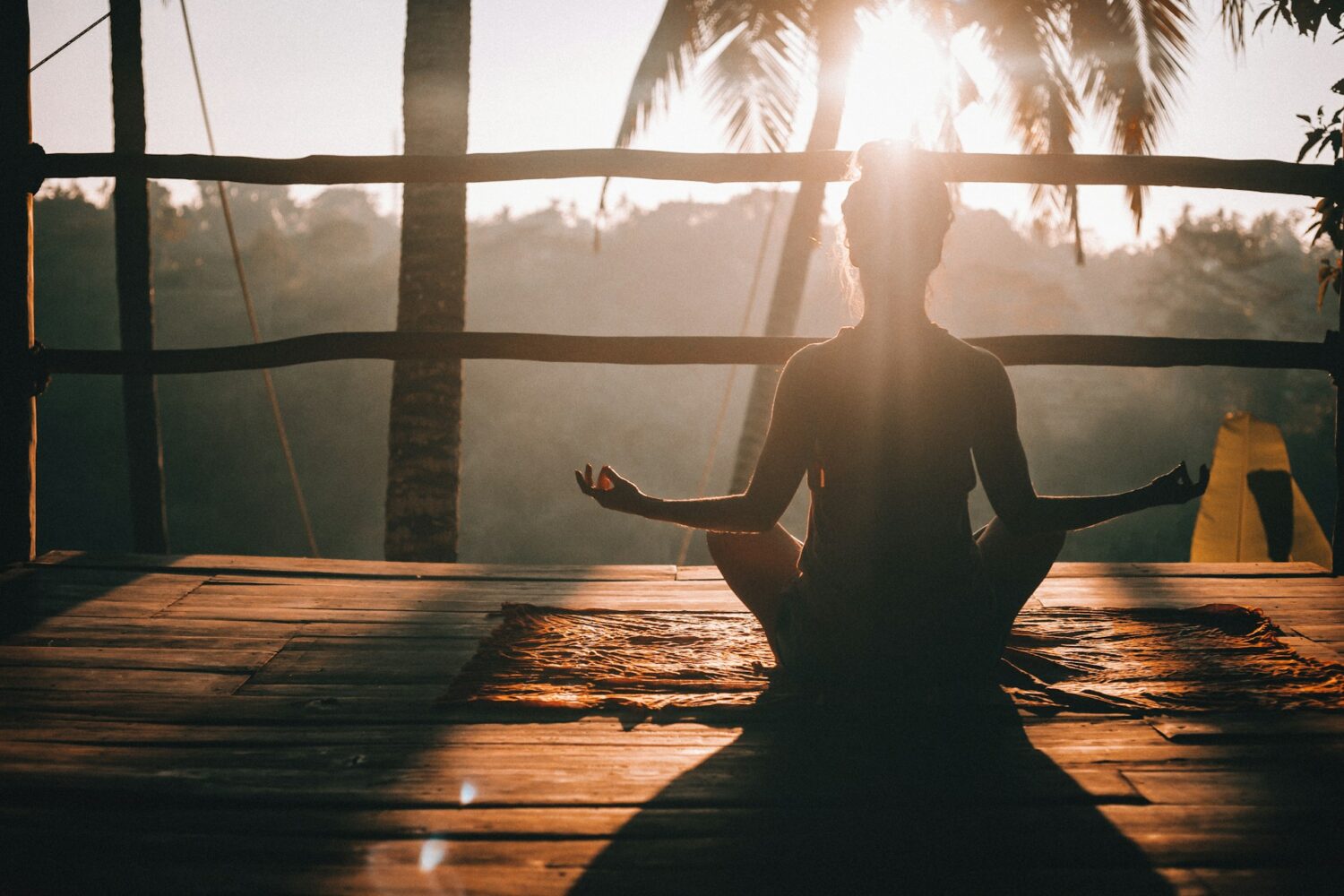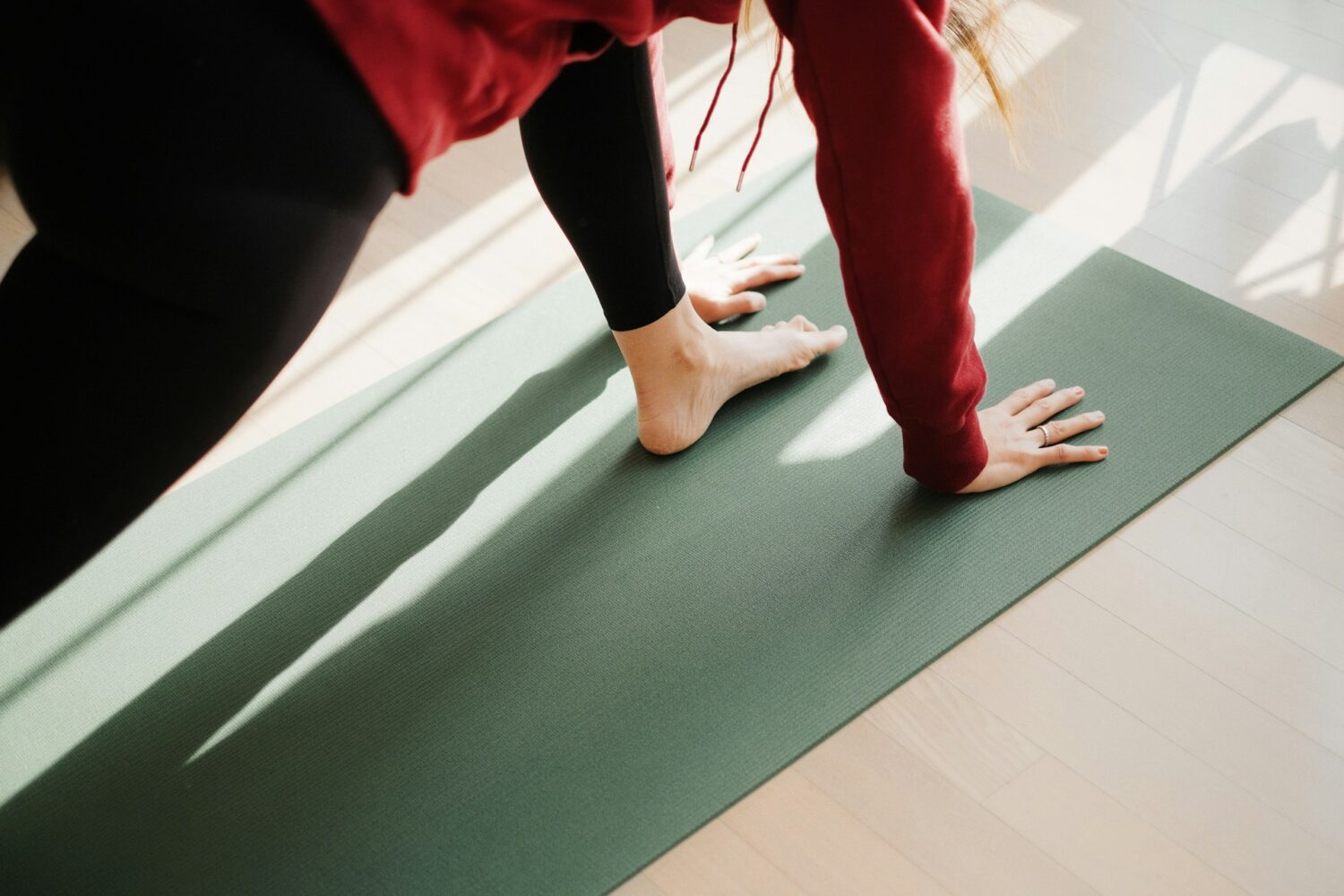Thinking about doing yoga regularly? These tips will help you make yoga practice a daily routine that will stick.

You Do… Yoga?
I answered the flow of standard hospital questions on autopilot. “Do you take any medicine?” – “No.” “Smoke?” – “No.” “ Do you exercise?” – “Yes, I do yoga in the morning.”
The last answer interrupted the flow, for just a few seconds. The next question “What time do you wake up?” was out of line.
I feel a little bit guarding, even protective every time I sit in front of hospital staff as a patient. It has a lot to do with one particular doctor years ago. Young, but already having somebody to shadow her, she didn’t have any medical explanations why I had a particular health issue. Some of my muscles were weak. Other than that everything seemed to be fine. I was as healthy as I could be.
And yet there was something wrong with me. Traditional medicine didn’t have the answers. At that point, it would not have raised my eyebrows if the doctor suggested that I try alternative medicine. Instead, with a hint that I might have been imagining, she self-assuredly said, “Don’t worry, many people experience the same issue at the age of 60.” “Really? But I’m just half this age.” I didn’t like her tone. I didn’t like her attitude.
That was the last time I went to see her. I still have the same issue. I just learned to live with it.
How Long Is Your Yoga Practice?
So now sitting next to the nurse, I answered every question with a certain discretion, never intending to give more information than required.
“What time do I wake up?” The question certainly implied more than just a professional interest. Or maybe there was evidence presented in the latest studies that showed some correlations between the time a person rises and her health?.. I didn’t know. But something was telling me that the nurse asked this question, driven by her personal curiosity.
“At 5”, I uttered reluctantly. “How long does your yoga session last?” “20, 15, sometimes 10 minutes, depending on the time I have.”
“I’ve always wanted to do yoga. Yoga is really good for your health. I’ve been wanting to start doing yoga at home. I snooze my alarm clock three times: at 6, then at 6:15 and 6:30. When the alarm goes off at 6:45, I have to get up and get ready for work. I should remember you next time I deliberately “jeopardize” my yoga practice.” I listened quietly as the nurse chastised herself for her far from ideal morning routine.
Roots of Yoga
For a zealous traveler as I am, yoga is a wide open door into Indian culture and traditions I yet to experience in person.
Yoga, which means “union” from the Sanskrit root “Yuj”, is a group of physical, mental and spiritual practices that aim to control the senses and still the mind. The word “yoga” was first mentioned in ancient sacred texts, the Rig Veda, more than 5,000 years ago.
Over the years, yoga was refined and further adapted by rishis (sages). The Indian sages passed on their practices and beliefs in the Upanishads, a series of Hindu sacred treatises.
Yoga reached the West in the late 1890s when Indian monks started spreading their ancient wisdom outside India. Swami Vivekananda is often credited with introducing yoga to the United States.
The Indian Hindu monk first came to the country in 1883 and was soon organizing world conferences where he talked about yoga as a “science of the mind”. The ancient discipline reached its major milestone at the 1893 Chicago World’s Fair where the swami himself demonstrated yoga.
The world welcomed the new teaching with open hands. Molding its doctrines to suit different cultures and traditions, the newly-found homeland eagerly adopted Hatha yoga (a slower pace yoga with focus on the breath, controlled movements, and stretching) and asanas (body postures). Religious tenets were abandoned.
Read more: 10 Books to Read before Traveling to India: Culture, History, Fiction
Health Benefits of Yoga
Today, yoga is mostly used as an exercise system for health, fitness, and inner well-being. The benefits of yoga are countless. Practicing yoga regularly improves flexibility, reduces stress, anxiety, and depression.
Yoga helps improve duration and quality of sleep. Gentle asanas can aid in regaining balance, support cardiovascular functioning, and boost the immune system.
Studies about the benefits of yoga for health and well-being are still new. But even without the scientific data, one can see that yoga promotes better posture and body awareness and thus improves self-esteem. And since yoga is a mind-body exercise system, it aims at improving brain functioning while sculpturing the body.

TIPS ON HOW TO MAKE YOGA A HABIT THAT WILL STICK
1. Define Your Purpose: Why Do You Want to Do Yoga?
Why do you want to do yoga? Are you worried about your health? Are you trying to lose weight? Do you feel overwhelmed by daily routine and need a special space and time to meditate but a traditional quiet meditation has never worked for you? Does yoga remind you of your trip to India? Did you start doing yoga at a retreat and want to continue this healthy practice at home? Or do you just like how yoga makes you feel?
Be specific. Be bold. Answer this question as honestly as you can. No one will know anyway. Just you and your desire to start doing yoga daily, at home or a yoga studio.
I’ve always been somewhat more flexible than my peers. I couldn’t and still can’t do splits. Handstands have been beyond impossible for me. But I could easily place my foot behind my neck while sitting on the floor.
When I was in my mid-twenties I understood one universal principle. If you don’t use it, you lose it. I wanted to maintain my flexibility level. Yoga looked like an ideal daily practice for somebody like me who didn’t want to slave away in the gym.
Without any prior experiences, I was huffing and puffing through my earliest yoga sessions. Some simple asanas would make me fly on the floor of my apartment over and over again. Yet I would get up and remind myself why I was “torturing” myself.
My yoga poses went from being awkward to smooth flows over time. While still taking periodic, short breaks, I’ve stuck with my morning yoga practice for years. It’s easier to make something a healthy habit when you know why you do it.
2. Choose the Right Time for Your Daily Yoga
I am a morning person. I have more energy for bigger tasks or things I must do in the morning. Unrolling a yoga mat a few minutes after I wake up comes naturally to me now. The house is still quiet with nothing or nobody to interrupt. I have less distractions to prevent me from doing a quick or longer yoga session.
Before I made a conscious commitment to start doing yoga in the morning, I tried to do some asanas right after I would come back home from work. I tried…
Empty refrigerator that needed an immediate refill, a long phone call that couldn’t be ignored, or just not feeling like doing it would get in the way more often than I dared to admit. One day of a missed yoga class would turn into two days, then a week. And before I noticed it, a month or two would fly by without a single yoga session.
You, on the other hand, may be the exact opposite. If it’s easier for you to stick to your daily yoga practice in the afternoon or evening, go for it.
If you’re not sure when is the right time for you to do yoga, do an experiment. Start your practice at different times of the day for a week or month and see when you fall into the flow more easily and naturally. The time when your yoga practice doesn’t feel like a dreadful task, but a relaxing routine or even a special form of meditation.
TIP: You can do yoga only three or five times a week. But make sure to sit on your mat at the same time. If you stick to it for a few weeks, your body will crave stretching yoga poses before your brain can even register it.

3. Decide Where You Want Do Yoga
A place where you practice yoga can help make it a daily habit or break it before the first roots and shoots emerge from the gentle seed you’re planting.
You can do yoga at home, eliminating any fear of judgment both internal and external. Or fired by social support and mutual commitment, you can follow instructions of a yoga teacher at the gym or yoga studio.
Some people reveal that by putting on their work-out clothes, mentally they are already half-way through their practices. “Dressing up” for my yoga class is an extra step that serves me rather adversely. Clothes that I wear as long as they don’t restrain my movements are enough. Plus I’m already 5 minutes into my actual yoga practice instead of just getting ready.
Who is Your Yoga Instructor?
When you first start doing yoga at home, you have to answer another question: who will be your instructor. My first “yoga teacher” was a Trudie Styler’s DVD that I picked up at Target on my way home from work. I followed this two-set routine for months until I mastered some basic yoga poses.
With plenty of yoga teaching channels on YouTube, the choices are broader now. Try different channels until you find something that works for you and stick with it. Over time, you will be able to build your own yoga routine. Just turn on relaxing music (YouTube can come in handy here as well) and let your body melt into stretching yoga asanas.
Joining a yoga class “forces” you to stick with it and increases chances of making it a daily habit. First you already paid money. If you skip the class, you lose the money. Simple like that.
Second, doing yoga surrounded by like-minded people can be the greatest motivator for some of us. Practicing the same poses together, excelling at some asanas, and falling on the mat while doing more challenging stretches, again together, takes the pressure off you. It demystifies the idea that you have to be a yogi to perform complicated asanas. These take time if it’s your goal.
For many of us, just moving our bodies under supervision of a qualified yoga teacher is enough. You will see health benefits. Your flexibility will increase over time. Yoga will teach you to focus on the now. Do you want to go further and become a certified yoga teacher after polishing your asanas at the yoga studio? Well, it’s your choice. Every big dream starts with small steps after all.

4. Leave Cues
Regardless of where you choose to do yoga, leave some cues that prompt you to stick with your new habit. I keep my yoga mat near a couch in our living room. It’s not on display so everybody can see it. But I know it’s there. I see it every time I turn on a lamp switch next to it. In the morning when I’m ready for my yoga practice, I just reach and grab it.
I would probably think twice whether I want to do yoga or not if I had to go upstairs and grab the mat from my room.
So to make yoga a habit that sticks, be sure to leave reminders around your house. A note with a yoga quote on your bathroom mirror. A picture or small meditation-yoga figurine on a shelf in your living room. A mat and yoga blocks, if you use them, within easy reach somewhere where you normally do your yoga practice. Again the less steps you need to make, the greater are the chances that you’ll stick with your daily yoga habit.
5. Showing Up for Your Yoga Practice
There will be times when you don’t feel like doing yoga. You wake up late and are in a rush to finish your morning chores before running out of the house. Or simply cuddling up with a book or a cup of tea without any distractions looks more appealing.
Whatever the excuse you may come up with, stop yourself right there. Pull out your yoga mat and start with an easy child pose. Before long you’ll be going through your entire yoga routine and feel proud of yourself at the end of it.
The trick is to show up for your yoga class every day. Some mornings or evenings when you can’t do the whole hour (if it’s your regular session), do 30 or 20 minutes. Even 10 minutes a day is enough to keep the ball rolling. And trust me, you will never regret pushing yourself a little bit harder on that particular day.
Read more: Longevity Secrets from Blue Zones